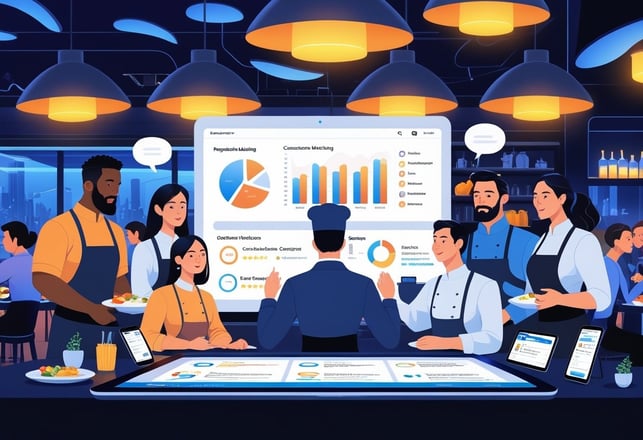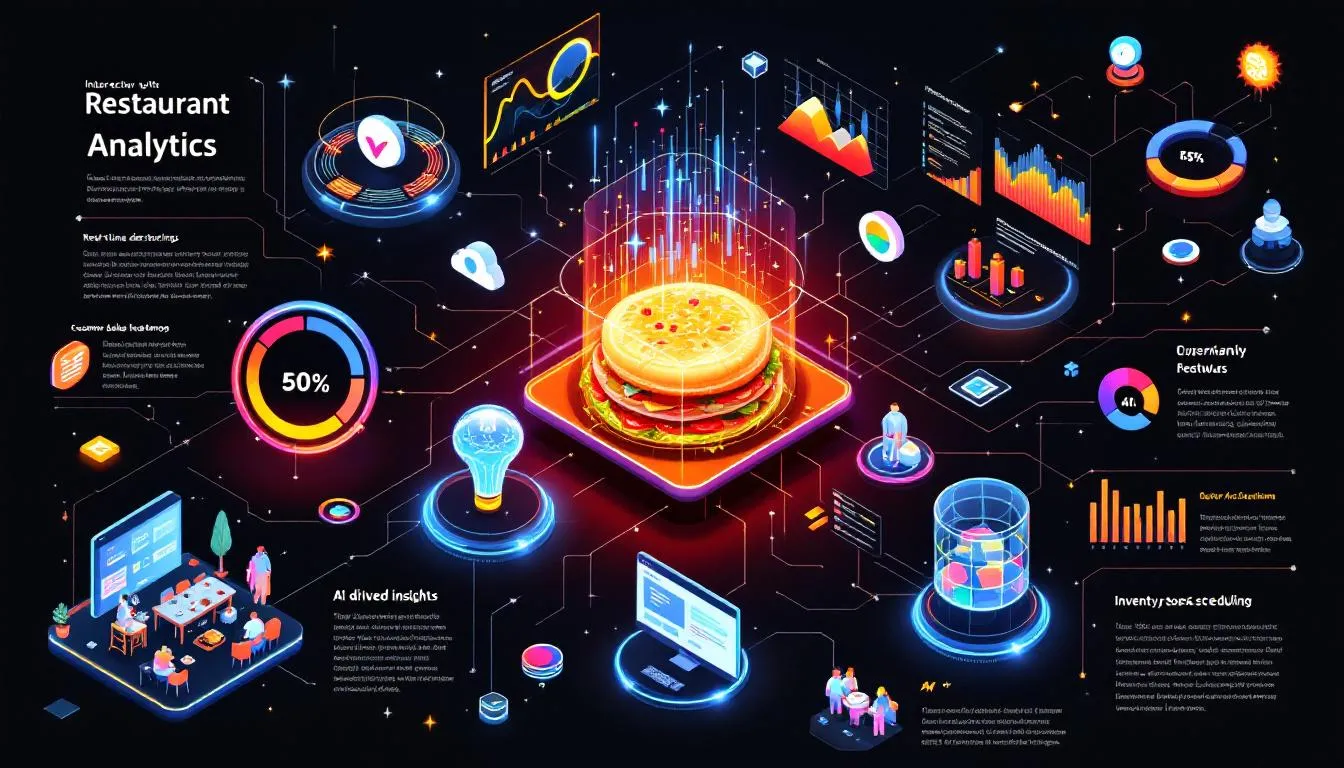Your restaurant's online reputation isn't just about racking up good reviews anymore. Restaurant reputation management is the ongoing process of tracking, responding to, and shaping how customers see your business across digital platforms to drive bookings and revenue.
In 2026, it's not just a nice-to-have, it's a core growth lever for any restaurant business. Your reputation now directly affects your search visibility and, honestly, where diners decide to spend their money.
.webp?width=640&height=438&name=undefined-Oct-29-2025-09-46-17-4745-AM%20(1).webp)
The link is straightforward: a stronger reputation means higher search rankings, more eyeballs on your listing, and more filled tables. With 94% of diners checking online reviews before booking, your digital reputation is shaping decisions before anyone even steps inside.
This playbook covers everything from setting up your Google Business Profile to crafting responses that can flip a negative review into a win. You'll get frameworks for juggling multiple review platforms, automation tools that actually save you time, and real stories of restaurants turning reputation challenges into new customers.
Why reputation management matters in 2025
Reputation management for restaurants now has a direct line to your Google Maps ranking and your booking numbers. Over 60% of diners scan restaurant reviews before picking a spot, so your online reputation can really make or break your business.
Google's review policies tightened in 2025. Fake reviews get nuked faster, but real negative feedback hangs around longer. Your restaurant's reputation now carries even more weight in local search than it did just a year ago.
The numbers are kind of wild:
- 53% of potential customers won't book restaurants under 4 stars
- Higher ratings bump click-through rates by 35%
- Restaurant owners who respond to reviews see 35% more revenue
- Poor ratings can slash Google Maps visibility by up to 70%
Platform changes are shaking things up. OpenTable is all about diner transparency now. Yelp's using AI to summarize reviews. Google's favoring recent, verified feedback over ancient history.
This all shapes how the public sees your business. A positive reputation brings in more bookings through better search visibility and trust. Your current reputation is basically a multiplier for your revenue.
The 5-step reputation management framework
Managing your restaurant's reputation needs a system that works whether you've got one location or multiple locations. This framework helps restaurant owners turn curious browsers into loyal regulars.
Monitor online ratings
You've got to keep an eye on what people are saying about you across every platform, every day. That means Google, Yelp, Facebook, and anywhere else diners might leave reviews.
Key monitoring tools:
- Google Alerts for your restaurant name
- Social listening tools for social media platforms
- Reputation dashboards
- Review notification apps
Someone on your team, maybe your FOH manager, maybe your marketing person, should own this. Monitor review sites daily and flag anything important.
Respond to public opinion
Speed matters here. Aim to respond to all reviews within 24 hours to show people you're paying attention and you care about customer satisfaction.
Positive review example: "Thanks for the kind words about our pasta! We're so glad you enjoyed your night."
Negative review example: "Sorry we missed the mark. Please call us at [number] so we can make it right."
Always lead with empathy. If there's a problem, try to solve it privately—phone or email is better than a public back-and-forth when handling negative feedback.
Request
Ask happy guests for reviews, but don't offer money or discounts. That'll backfire and it's against the rules anyway.
Best times to collect reviews:
- Right after the meal with a QR code on the receipt
- Follow-up email a couple days later
- Text message for delivery orders
Google and Yelp are strict about this, so keep your ask short and honest when you encourage customers to leave reviews.
Analyze online reviews
Dig into your reviews for patterns. What are people loving or hating? Group customer feedback by themes like "wait time," "food quality," or "friendly staff."
Sentiment analysis tools can help track if things are trending up or down. Dashboards make it easier to spot issues before they snowball.
Improve
Take what you learn and actually change things. If people complain about slow service, train your team or tweak your process to meet customer expectations.
Share positive feedback with your staff members—it keeps everyone motivated. When you make improvements based on reviews, let your team know their efforts matter.
Set up your foundations – Google Business Profile and listings
%20(2).webp?width=640&height=438&name=undefined-Oct-29-2025-09-46-16-4279-AM%20(1)%20(2).webp)
Bottom line: Your restaurant's online reputation starts with a dialed-in Google Business Profile and matching info across review sites. This is the bedrock for building trust and getting found online.
Claim and optimize your Google Business Profile
Head to Google Business Profile and claim your listing. Google will mail you a postcard to verify you actually own the place.
After you're verified, fill out every section:
- Business name, address, phone (NAP) – Use the same info everywhere
- Hours – Update for holidays and seasons
- Categories – Pick your main cuisine and any secondary ones
- Description – Write a short, real description of your spot
- Photos – Show off your food, space, and menu
- Menu link – Connect to your current menu
Try to upload new photos every week or so—Google likes active listings, and it helps build a positive image.
Maintain directory consistency
List your restaurant on these major review platforms with identical info:
- Yelp – Big for local reviews
- TripAdvisor – Key for tourists
- Facebook – Good for community
- OpenTable/Resy – If you do reservations
Double-check that your NAP matches everywhere. Even little differences can mess up your search rankings and hurt your positive online reviews.
Add structured data
Use menu schema markup on your website. That helps search engines understand your menu and pricing, which can boost visibility.
Quick tip: Set a weekly five-minute reminder to check your listings. Make sure your hours are right, respond to new reviews, and see if your photos are showing up okay.
Channel-specific playbooks
%20(2).webp?width=640&height=438&name=undefined-Oct-29-2025-09-46-17-8734-AM%20(1)%20(2).webp)
Each review site is its own beast. You'll need different approaches for each one if you want to max out your positive reviews and get noticed.
Google reviews
Google powers 60% of restaurant discovery searches. Your rating here is a big deal for local rankings and whether potential guests trust you.
How to respond:
- Reply to all reviews within a day
• Work in location-specific keywords, but don't force it
• Thank people by name if they mention it
For positive reviews, thank them and mention any dishes they called out. For complaints, acknowledge the problem publicly and move it to private channels to fix it—this helps maintain a good reputation.
Yelp and TripAdvisor
Yelp is big with locals and younger diners. TripAdvisor is more for tourists and out-of-towners in the restaurant industry.
Key rules:
- Don't ask for reviews in person on Yelp (they'll ding you for it)
- No incentives for positive reviews on either site
- Keep uploading fresh, high-quality food photos
TripAdvisor folks want details about location, parking, and tourist-friendly options. Yelp users care about authenticity and local flavor.
Social media mentions
Check Instagram tags, Facebook comments, and TikTok mentions every day. Social media can create viral moments that fill seats fast.
Best practices:
- Share user-generated content (with permission) to encourage more positive reviews
- Jump on negative posts quickly and keep it professional
- If there's a crisis, keep your responses short and focused on solutions
Tools & automation – what to look for in software
Restaurant reputation management software lets you track and respond to reviews from all platforms in one place. The right reputation management software can actually save valuable time by automating review gathering, responses, and analysis.
Must-have features:
- Unified inbox – See Google, Yelp, Facebook, and delivery app reviews together on one platform
- Auto-reply templates – Keep your voice consistent with review response templates
- Sentiment analysis – Spot trends in positive or negative feedback
- Analytics dashboard – Track review volume, online ratings, and response speed
- Integrations – Connect with DoorDash, Uber Eats, etc.
Once you're getting more than 50 reviews a month or running multiple locations, you'll want software. Manual tracking just won't cut it for managing your restaurant's reputation.
Some solid options: SevenRooms for reservation-heavy spots, Bloom Intelligence if you use WiFi to gather reviews, and Eat App Review Management for restaurant-specific automation. Restaurant reputation management simplifies when you use the right tools.
Look for platforms with real-time alerts so you can jump on new reviews fast. The best ones also help you stay compliant with each site's rules.
Operationalizing responses – scripts & SLAs
%20(2).webp?width=640&height=438&name=undefined-Oct-29-2025-09-46-17-1297-AM%20(1)%20(2).webp)
Set up clear response systems so you can handle online feedback fast—and keep your tone on-brand. Put time limits on replies, and train your staff to use templates that actually sound like your business, not a robot.
Quick response framework
Always try to send an initial response within 24 hours for negative reviews. Templates help you move faster, but don't let them sound canned—make sure replies feel personal. Your team should be gathering review data and keeping an eye out for patterns in feedback.
|
Platform |
Ideal first-response time |
Owner |
Example tone |
|
|
24 h |
Marketing Mgr |
Professional + grateful |
|
Yelp |
24-48 h |
GM |
Empathetic + action-oriented |
|
TripAdvisor |
48 h |
FOH Lead |
Polite + factual |
Ready-to-use templates
Positive review: "Thanks [Name] for the kind words about [specific detail]! We're thrilled you enjoyed [menu item/experience]. See you soon!"
Mixed review: "Hi [Name], thanks for the feedback. I'm sorry about [issue] but glad you liked [positive aspect]. We've fixed [solution]. Please reach me at [contact]."
Negative feedback: "[Name], I apologize for [specific problem]. We've [action taken] and added [prevention step]. Contact me at [direct email] to make this right."
Fake review: "We don't see this visit in our records for [date mentioned]. Please contact us directly at [phone] so we can help."
Escalation rules
Send food safety claims, discrimination reports, or legal threats to your GM within 2 hours. Train everyone on keeping the tone steady—monthly practice sessions help. Customer surveys can tip you off to issues before they spill onto review sites.
Measure what matters
Track the right metrics if you want all this reputation work to actually show up in your results and boost revenue. Not every data point is worth your time; focus on what really affects customer satisfaction and revenue.
%20(2).webp?width=640&height=438&name=undefined-Oct-29-2025-09-46-16-7777-AM%20(1)%20(2).webp)
Essential KPIs to monitor monthly:
- Average rating - Keep it at 4.3+ stars everywhere.
- Review volume & velocity - Count new reviews each week or month.
- Response rate & time - Shoot for 100% responses, all within 24 hours.
- Sentiment themes resolved - Watch for recurring complaints.
- Reservation lift - See if improved ratings actually boost bookings.
- Customer retention rate - Are people coming back after good interactions and building customer loyalty?
Hold monthly meetings to review these numbers with your team. Spot trends—maybe food quality issues pop up, or service complaints keep repeating.
Connect metrics to revenue
When your rating jumps from 3.8 to 4.3 stars, bookings tend to climb 30-40%. Yeah, that's a huge difference. Watch how ratings move the needle on table bookings.
Keep tabs on review themes. If you keep seeing "slow service," that's a red flag—time for a staff training refresh.
Use analytics integration
Platforms like Eat App can tie reservation data to review scores. Then you actually see which improvements are getting customers to come back and contributing to long term success.
Case mini-scenarios
Here are three real-world situations that show how smart reputation management turns problems into wins for a successful restaurant.
Scenario 1: High volume, low rating
Your pizza place has 400 Google reviews but only 3.2 stars. Ouch. But hey, more data means you can fix things faster.
Read your last 50 reviews. Look for patterns—are people upset about cold food, rude staff, or wrong orders?
Set up a simple tracking sheet. Log each complaint type and how often it pops up. Now you know what to fix first.
Tackle the biggest issue right away. If 60% of complaints mention cold pizza, your delivery process or warming equipment is probably the culprit.
Respond to recent negative reviews and tell customers exactly what you changed. Invite them back to give you another shot. Actively managing these responses shows you care about service.
Outcome: Average rating bumped up +0.3 points in 60 days after fixing delivery temperature problems—building trust with how many customers who had complained before.
Scenario 2: New location review flood
Your second spot just opened and you're getting 15 new Google reviews every day. Some are glowing reviews, others call out opening week hiccups.
Set up review alerts on your phone. Respond to every review within 12 hours, especially the negative ones during your first month.
Thank happy reviewers and mention what they liked. For negative reviews, apologize and explain what you're working on to improve.
Create templates, but tweak them each time. People can spot copy-paste jobs a mile away.
Outcome: Held onto a 4.2-star average despite opening chaos, and 89% of unhappy reviewers updated to positive ratings—proof of the power of managing your restaurant's reputation from day one.
Conclusion
At the end of the day, restaurant reputation management in 2026 still boils down to a five-step framework that shapes how guests see you.
Consistency builds trust, and trust brings in more revenue. It’s a cycle—better reviews, more diners, better reviews again.
Your reputation really does hit your bottom line. Even a one-star bump can mean 5-9% more revenue. That’s not just pocket change.
People are reading your reviews right now, whether you like it or not. Make sure they’re seeing the story you want to tell. Every positive online interaction is a chance to bring new faces through your doors.
And honestly, isn’t it better to shape your own story than let the internet do it for you? If you’re ready to get serious, try Eat App. It’s centralized, quick, and friendly for guests and staff alike.
FAQ
What is restaurant reputation management?
Restaurant reputation management is basically your way of keeping tabs on how people see your business online. You keep an eye on reviews across Google, Yelp, and social media platforms, and then jump in to respond when needed.
How fast should I respond to a negative review?
Ideally, you want to reply to negative reviews within 24 hours. Quick responses show guests that their concerns matter to you.
Apparently, about 70% of folks are more likely to come back if their complaints are handled politely. So, acting fast can sometimes turn a bad situation around.
How can I ask guests for reviews without breaking rules?
It's fine to ask happy guests for honest feedback after their meal. A quick follow-up text or email with a link to your Google Business Profile usually does the trick when you want to collect reviews.
What should I do about fake or unfair reviews?
If you spot a fake review, report it to the platform right away. Google does remove stuff that breaks their rules, like spam or hate speech.
Unfortunately, you can't take down legitimate negative reviews, even if you think they're unfair. That's just part of managing reputation in the restaurant business.















-1.png?width=1812&height=1072&name=TripAdvisor%20%26%20More%20Bookings%20(1)-1.png)
-2.png?width=1812&height=1072&name=Google%20Bookings%20(1)-2.png)


-1.png?width=200&name=TripAdvisor%20%26%20More%20Bookings%20(1)-1.png)
-2.png?width=200&name=Google%20Bookings%20(1)-2.png)
-1.png?width=200&name=Instagram%20Bookings%20(1)-1.png)
-1-png.webp?width=200&name=Facebook%20Integration%20Rectangle%20(1)-1-png.webp)







.webp?width=200&name=download%20(1).webp)
%20(1)-2.webp?width=200&name=Eat%20(34)%20(1)-2.webp)
%20(1)-2.webp?width=200&name=Eat%20(18)%20(1)-2.webp)






.webp?width=314&height=175&name=undefined-Nov-13-2025-10-01-55-9751-AM%20(1).webp)




.webp?width=144&height=72&name=Eat%20App%20Logo%20(3).webp)